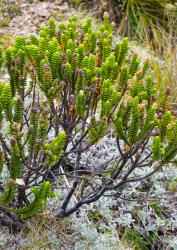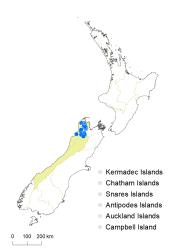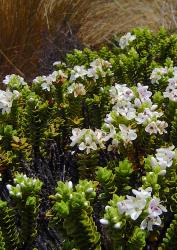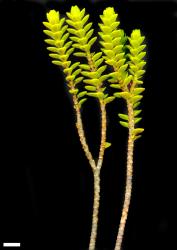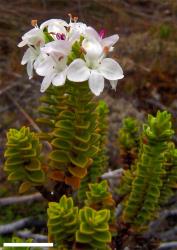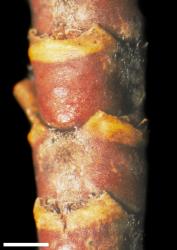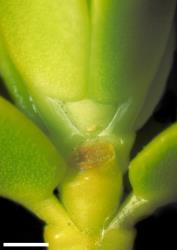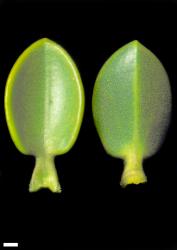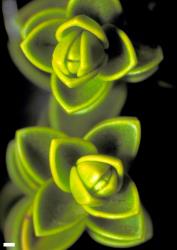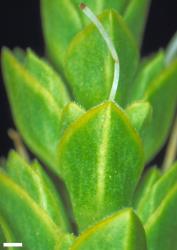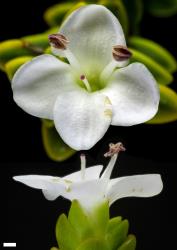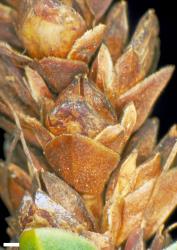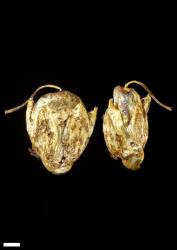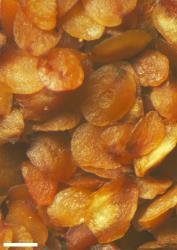- Taxon
- Gallery
- ≡ Hebe pauciramosa var. masoniae L.B.Moore in Allan, Fl. New Zealand 1, 926 (1961) – as masonae
- ≡ Leonohebe masoniae (L.B.Moore) Heads, Bot. Soc. Otago Newsl. 5: 10 (1987)
- ≡ Hebe masoniae (L.B.Moore) Garn.-Jones, Austral. Syst. Bot. 6: 478 (1993)
- = Leonohebe masoniae var. rotundata Heads, Bot. Soc. Otago Newsl. 5: 11 (1987)
Shrub to 0.5 m tall. Stems decumbent or ascending to erect, eglandular-pubescent; hairs bifarious. Leaf bud distinct, its leaves appressed at margins until fully grown; sinus broadly shield-shaped. Leaves opposite-decussate, erecto-patent to spreading; lamina coriaceous, rigid, oblong to broadly oblong, to elliptic to sub-orbicular, 3–10 mm long, 4–8 mm wide, glossy green to dark green above and beneath, sometimes yellowish, especially on margins; midrib beneath and occasionally two faint lateral veins evident; surfaces glabrous; margin smooth or minutely papillate distally, ciliolate when young, entire; apex obtuse and slightly apiculate; base truncate to sub-cordate; petiole 1–2 mm long. Inflorescence a simple or compound terminal spike, 8–18 mm long; flowers crowded, 2–14, all bisexual; bracts opposite-decussate and connate, elliptic to sub-orbicular or rhomboid, ≥ calyx; pedicels absent. Calyx lobes 4, obtuse to sub-acute, 5.0–6.5 mm long, unequal, eglandular-ciliate, rarely with a few glandular hairs as well. Corolla 10–15 mm diameter; tube white, 4.5–6.0 mm long, = or slightly > calyx, eglandular-hairy in tube, with small glandular hairs at throat; lobes 4, white, sometimes purplish or pink, erecto-patent to recurved, sub-equal, elliptic to broadly obovate or sub-orbicular, 5–7 mm long, rounded; nectar guides absent. Stamen filaments white 5–8 mm long; anthers magenta. Style glabrous, 7–9 mm long. Capsules latiseptate, sub-acute to obtuse, glabrous, 4–5 mm long, 3.5–4.0 mm at widest point. Seeds ellipsoid to circular, flattened, smooth, pale brown, 1.5–2.1 mm long.
odora | mooreae | pauciramosa | masoniae | venustula | brachysiphon | |
|---|---|---|---|---|---|---|
Leaf bud sinus | broad, shield-shaped | narrow & acute to broad & shield shaped | broad, shield-shaped | broad, shield-shaped | narrow, acute | narrow, acute |
Leaf margin | sharply bevelled; glabrous | bevelled at 90º to surfaces, glabrous | rounded; glabrous or with minute hairs or denticles | rounded, papillate towards apex; ciliolate when young | weakly bevelled; ciliolate when young, becoming glabrous or papillate | weakly bevelled; ciliolate to ciliate when young, becoming papillate |
Stomata | adaxial – (but often + at Arthur’s Pass); abaxial + | adaxial – (+ at Caswell Sound, Denniston); abaxial + | adaxial +; abaxial + | adaxial +; abaxial + | adaxial ±; abaxial + | adaxial ±; abaxial + |
Midrib | sharply keeled beneath | depressed above; prominent beneath | rounded beneath and flattened just short of apex | keeled throughout | evident but not keeled | evident but not keeled |
Inflorescence | terminal + usually lateral spikes | lateral spikes only | lateral spikes only | terminal spikes only | lateral raceme, sometimes ternate, rarely compound. | lateral raceme, sometimes ternate. |
Bracts | not overtopping calyx | < calyx | < calyx | ≥ calyx | ≥ pedicels, < calyx | ≥ pedicels, < calyx |
Bracts and flowers | opposite | opposite | opposite | opposite | opposite below, becoming alternate | alternate, or lowermost opposite |
Pedicels | 0 mm | 0–1 mm | 0–0.5 mm | 0 mm | 0.5–7.0 mm | 0.6–3.0 mm |
Calyx, anterior lobes | free | free or fused to ⅓-way | fused > ⅔-way | free | free | free |
Corolla lobes | narrow | broad | narrow | broad | ± broad | ± broad |
South Island: Western Nelson, Westland (from Boulder Lake to the Braeburn Range).
Sub-alpine to penalpine tussock grassland, carpet grass (Chionochloa australis) and low scrub, sometimes in wet sites. Recorded elevations range from 769 to 1553 m.
Flowers: October–April; fruits: January–May (sometimes persisting until November).
2n = 118 (see Bayly & Kellow 2006, as Hebe masoniae).
Veronica masoniae is classified in V. subg. Pseudoveronica sect. Hebe and the informal group “Buxifoliatae” (Albach & Meudt 2010; Bayly & Kellow 2006). Although V. masoniae resembles V. pauciramosa (with which it was included until 1987) and V. odora, analysis of ITS sequence data (E.M. Low, unpublished) places it among a large and poorly resolved clade of shrubby hebes that mostly have 2n = 40, 80, 120. Further research to clarify its position and origins is needed.
Flowers of both V. masoniae and V. pauciramosa have characteristic dark red stigmas.



